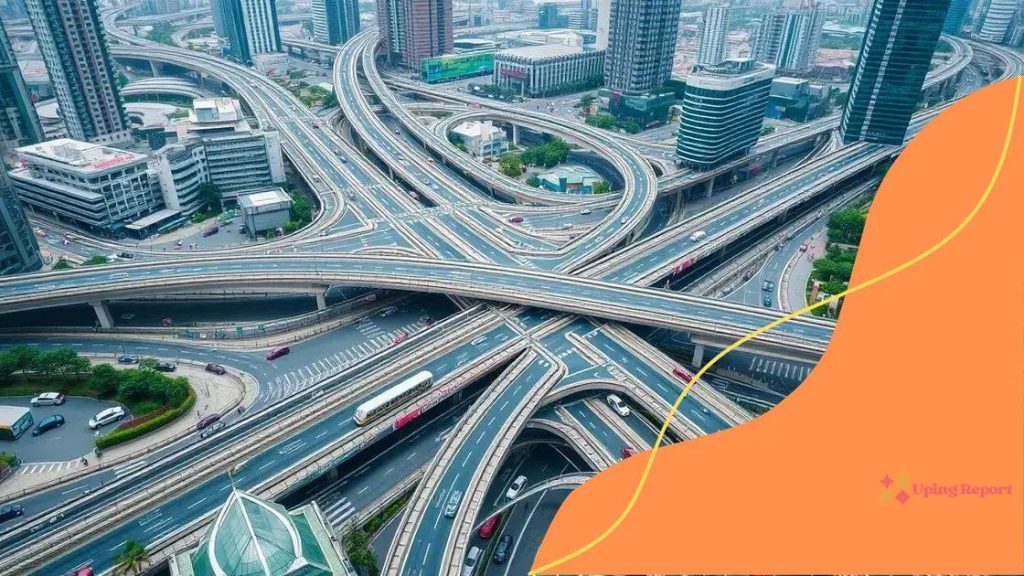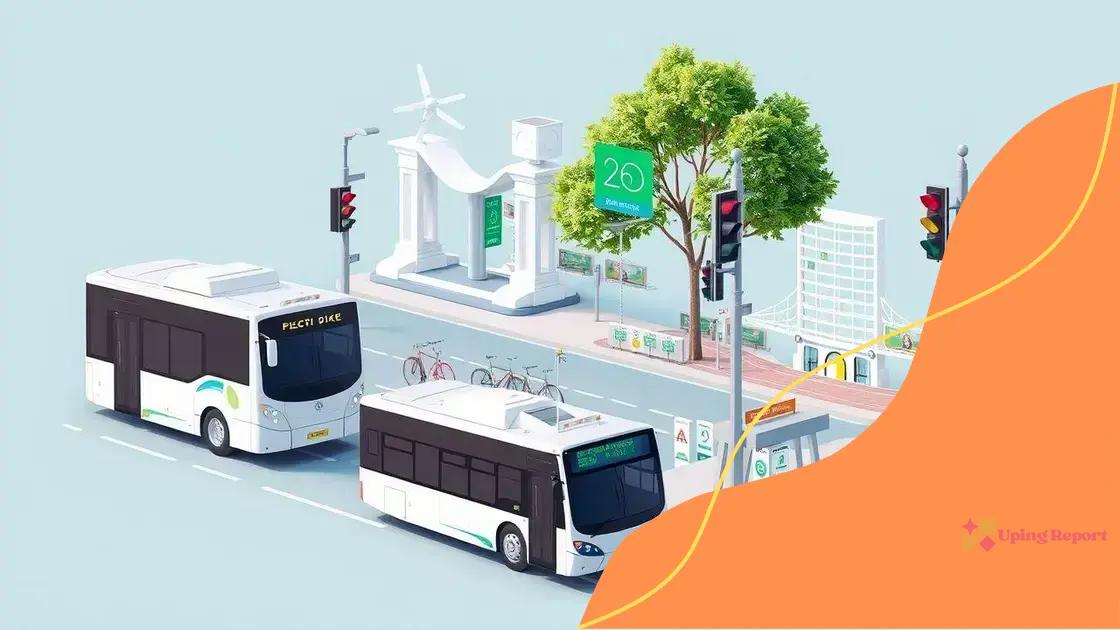Transportation infrastructure investments and their impact

Transportation infrastructure investments are crucial for economic growth, sustainability, and community connectivity, driven by technological advancements and the need for equitable access.
Transportation infrastructure investments are crucial for the development of cities and regions. Have you ever wondered how these investments affect your daily commute or local economy? Let’s explore the importance of this topic.
The importance of strong transportation infrastructure
The importance of strong transportation infrastructure cannot be overstated. It serves as the backbone of a functional economy, enabling people and goods to move efficiently. When cities have reliable roads, bridges, and transit systems, they promote economic growth and improve quality of life for their residents.
Key Benefits of Strong Infrastructure
Investing in strong transportation facilitates better access to jobs and services. This can lead to:
- Increased job opportunities as businesses thrive in well-connected areas.
- Reduced travel times, making it easier for individuals and families to get to work or school.
- Enhanced safety for all road users, including pedestrians and cyclists.
- Boosted local businesses due to increased foot traffic and accessibility.
Moreover, strong transportation systems help mitigate traffic congestion. When roads and public transportation are well-maintained and designed, they can handle larger volumes of traffic without slowing down the movement of people and goods. A well-planned infrastructure also encourages the use of public transport, which can reduce environmental impact by lowering carbon emissions.
Community Impact
Strong transportation infrastructure also plays a crucial role in community building. It connects neighborhoods and fosters social interactions among residents. When people can travel easily across their communities, it allows for better cultural exchange and stronger social ties.
Additionally, well-maintained transportation systems contribute to an area’s attractiveness. Potential buyers and renters often look for regions with good access to public transit and efficient road networks. This can increase property values and attract new residents.
In conclusion, the significance of strong transportation infrastructure extends beyond mere convenience. It is essential for economic growth, environmental sustainability, and community well-being. Investing in it can foster a thriving society that benefits everyone.
Key benefits of investing in transportation
Investing in transportation brings many key benefits to communities and economies. These advantages go beyond just getting from one place to another; they shape how we live and work.
Economic Growth
One major benefit of investing in transportation is the boost it provides to economic growth. Better transportation networks lead to:
- Increased efficiency in moving goods and services.
- More job opportunities created by businesses near transport hubs.
- A stronger connection between local, regional, and global markets.
When transportation is reliable and efficient, businesses can operate more effectively. This means lower costs and faster delivery times, which can significantly enhance profits.
Environmental Benefits
Another important aspect is the positive impact on the environment. Sustainable transport systems can:
- Reduce traffic congestion, leading to lower emissions.
- Encourage public transportation usage, which is often more eco-friendly.
- Promote the development of green spaces by reducing the need for sprawling highways.
By investing in eco-friendly transportation options, cities contribute to a cleaner and healthier planet. This can include expanding bike lanes or enhancing public transport to reduce the number of cars on the road.
Furthermore, investing in transportation enhances community connectivity. Well-planned transport systems help connect people to essential services like schools, hospitals, and jobs. Improved access encourages greater participation in local activities and strengthens social bonds within communities.
As we continue to grapple with rapid urbanization, addressing transportation needs is critical. Investing wisely in infrastructure means creating spaces that foster growth, sustainability, and a better quality of life for all.
Current trends in transportation investments

Current trends in transportation investments reflect a shift toward more sustainable and technology-driven approaches. As cities grow and populations increase, investing in modern transportation solutions becomes crucial.
Focus on Sustainability
One key trend is the emphasis on sustainability. More cities are looking for eco-friendly transportation options. This includes:
- Expanding public transportation systems to reduce car dependence.
- Investing in electric buses and vehicles that minimize emissions.
- Creating bike lanes and pedestrian-friendly areas to promote alternative modes of transit.
These efforts not only help the environment but also enhance the quality of life for residents. When public transit is more efficient, people are more likely to use it.
Smart Transportation Technologies
Another significant trend is the integration of smart technologies into transportation networks. This includes:
- Using real-time data to manage traffic flow and reduce congestion.
- Implementing smart traffic signals that adapt to road conditions.
- Incorporating apps that provide travelers with updated transit information.
With these advancements, transportation systems become more efficient and user-friendly. They streamline the travel experience and encourage people to choose public options.
Furthermore, there is an increasing focus on multimodal transportation solutions. This means investing in systems that connect different ways of getting around, such as trains, buses, and bike-sharing programs. By linking these modes of transport, cities can provide seamless travel experiences for their residents.
In summary, current trends in transportation investments highlight the importance of sustainability and technology. As we look toward the future, these investments will be key in creating efficient, livable cities.
Challenges in funding transportation projects
Funding transportation projects is a complex issue filled with numerous challenges. A significant challenge is the reliance on government funding, which can be unstable. When budgets are tight, transportation projects often face delays or cuts. This instability can hinder the development and maintenance of vital infrastructure.
High Costs and Budget Constraints
Another issue is the high cost of building and upgrading transportation systems. Expenses for materials, labor, and technology can quickly add up. In many cases, cities struggle to secure enough funding to cover these costs. This leads to:
- Delayed projects, which can worsen traffic congestion.
- Increased workload on existing infrastructure.
- Missed opportunities for economic growth.
As construction prices continue to rise, many regions find it challenging to keep up with the demand for new and upgraded transportation solutions.
Public-Private Partnerships
Public-private partnerships (PPPs) have emerged as a potential solution for funding transportation projects. However, these partnerships come with their own set of challenges. While they can provide additional funding sources, they often require long negotiation periods and complex contracts. This complexity can lead to:
- Extended timelines for project approval.
- Potential misalignment of goals between public entities and private investors.
- Concerns about equity and access for all community members.
Moreover, securing long-term funding commitments from private companies can be difficult. If a private partner backs out, it can jeopardize the entire project.
Finally, community support plays a crucial role in funding transportation initiatives. Local residents and stakeholders may oppose certain projects, fearing disruptions or changes to their neighborhoods. Gaining public buy-in is essential, but it can add another layer of complexity to the funding process.
In summary, the challenges in funding transportation projects require innovative solutions and effective collaboration among public and private stakeholders. Addressing these challenges is vital to develop sustainable and efficient transportation networks.
Future outlook for transportation infrastructure
The future outlook for transportation infrastructure is both exciting and challenging. As we move forward, several key trends will shape the way we design and implement transportation systems.
Technological Advancements
One major aspect is the impact of technology. Innovations in artificial intelligence (AI) and data analytics are changing how we manage transportation systems. These technologies can:
- Optimize traffic flow using real-time data to reduce congestion.
- Enhance safety through smart traffic management systems.
- Improve user experience with mobile apps that provide accurate transit information.
As these technologies evolve, they will play a crucial role in creating more efficient and reliable transportation networks.
Sustainability Initiatives
Sustainability will also be a driving force in the future of transportation. Cities worldwide are committing to reducing their carbon footprints and enhancing public transit options. This shift includes:
- Investing in electric and hybrid vehicles to decrease emissions.
- Building more bike lanes and pedestrian pathways to promote eco-friendly travel.
- Enhancing public transportation systems to reduce reliance on personal cars.
By prioritizing sustainability, communities can create healthier environments and improve the quality of life for residents.
Moreover, there is a growing emphasis on equity in transportation planning. Ensuring that all community members have access to reliable and affordable transportation options is essential. This focus will help bridge gaps for disadvantaged communities and promote social inclusion.
In addition, governments and private sectors are increasingly exploring alternative funding mechanisms to support infrastructure projects. Innovative financing methods, such as green bonds or public-private partnerships, can provide the necessary resources to bring ambitious transportation initiatives to life. These approaches can also help overcome current funding challenges and lead to improved infrastructure.
In summary, the future of transportation infrastructure will be shaped by technology, sustainability, and equity. As we adapt to these changes, focusing on creating inclusive and environmentally friendly systems will be vital in meeting the needs of future generations.
transportation infrastructure, several key themes emerge. First, technology will play a huge role in enhancing efficiency and safety. Second, sustainability is becoming a priority in building new systems. Third, equitable access to transportation is essential for all communities. Finally, innovative funding methods are needed to support these vital projects. Together, these aspects will help create a more connected, eco-friendly, and inclusive transportation system for everyone.
FAQ – Frequently Asked Questions about Transportation Infrastructure
What are the key benefits of investing in transportation infrastructure?
Investing in transportation infrastructure enhances economic growth, improves access to services, promotes sustainability, and increases community connectivity.
How will technology impact future transportation systems?
Technology will optimize traffic management, enhance safety, and improve user experience through real-time data and smart applications.
What challenges are faced in funding transportation projects?
Challenges include reliance on unstable government funding, high costs of construction, complexity in public-private partnerships, and the need for community support.
Why is sustainability important in transportation infrastructure?
Sustainability is crucial as it reduces environmental impact, promotes public transport use, and contributes to healthier urban living conditions.
